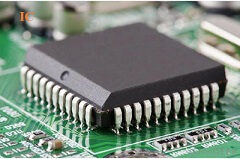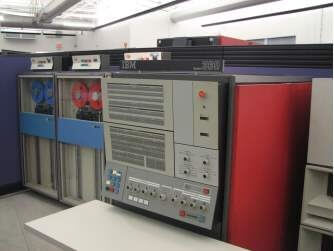Third Generation of Computer
The third generation of computers used integrated circuits instead of transistors technology that was used in computers of second-generation. Its time period was around 1964 to 1970. An integrated circuit is a small chip that was the trademark of the computers of third generation. The integrated circuit used in 3rd generation computers can work as computer memory, microprocessor or even an amplifier. The first to develop the idea of the integrated circuit was Robert Noyce of Fairchild Semiconductor and Jack Kilby (American electrical engineer) of Texas Instruments in 1959. The landscape of computing had completely changed by the integrated circuit in the 1960s, which is a single that have multiple transistors. The integrated circuit looks like as shown in the below image:

As compared to first and second generations of computers, the technology used in the 3rd generation computers made them more reliable, efficient and smaller in size. Also, comparing to the previous two generations of computers, the computers made in the third generation used integrated circuit came with features; such as faster speed, reliability, generated less heat, lesser maintenance. They consumed lesser electricity; still costly, and were needed air condition.
Arguably the most important machine of the third generation was the IBM-360 series, which was more powerful, fastest in use at that time. Some say the third generation of computers was introduced by this machine, IBM System/360 introduced in 1966. The developing cost of this machine was approximately $5 billion, which was spent by IBM. Especially, this machine was designed by IBM to manage high-speed data processing for scientific uses like global weather forecasting, theoretical astronomy, space exploration and subatomic physics. Over a family of devices, it proposed a single computer architecture that was not an innovative perspective to computer design.
The IBM System/360 Model 50 was capable of about 263 times as fast as in the comparison of the ENIAC. At a price in today’s dollars of $4,140,257, this model of IBM could execute 500,000 additions per second. An estimate by IBM was that the Model 91 would be capable of solving over 1,000 problems as well as around 200 billion calculations. The below image is an instance of an IBM System/360. It was looked like the below image when it was introduced.

At the time of the third generation of computers, multiple integrated circuits were needed to construct the central processor. The idea of placing an entire processor on a single silicon chip was not until the fourth generation. Moreover, the multiprogramming operating system, time-sharing and remote processing were used in the third generation of computers. During this generation, high-level programming languages such as ALGOL-68, FORTRAN-II TO IV, BASIC, COBOL, PASCAL PL/1, and more were used. Other examples of third-generation computers are PDP, Honeywell-6000 and DEC series.
Characteristics of Third Generation Computers
As third generation computers were made by using an integrated circuit that led to various features, which are as follows:
- Instead of using individual transistors, the computers made in the third generation used integrated circuits technology.
- As compared to second-generation computers, 3rd generation computers were cheaper in price, smaller in size, less heavy in weight, faster in speed and more efficient.
- High-level programming languages such as ALGOL-68, FORTRAN-II TO IV, BASIC, COBOL, PASCAL PL/1 were used.
- These computers were introduced with magnetic storage.
Advantage and Disadvantages of Third Generation Computers
As the third-generation computers were made with the help of an integrated circuit that led to numerous benefits and limitations of the computer world and the users. For example, comparing to the previous two-generation computer, the third-generation computers were consistently good in quality and performance, meaning they were more reliable. Also, they produced less heat and consumed less energy. The disadvantage of the third-generation commuters was that they still required air conditioning even if they produced less heat.
There are some other examples of advantages of the computers made in the third generation included: as compared to previous two generations of computers, third generation computers were fast in speed (quick in calculating data), versatile to an extent, cheaper in price, higher storage capacity, as well as more accurate. However, the producing and making process of the third generation of computers was more expensive; because it needed too much amount of money for the manufacturing of Integrated Circuit chips. Especially, they were expensive for manufacturers of the 3rd generation of computers. Some points of advantages and disadvantages of computer made in the third generation are given below:
| ADVANTAGES | DISADVANTAGES |
|---|---|
|
|
